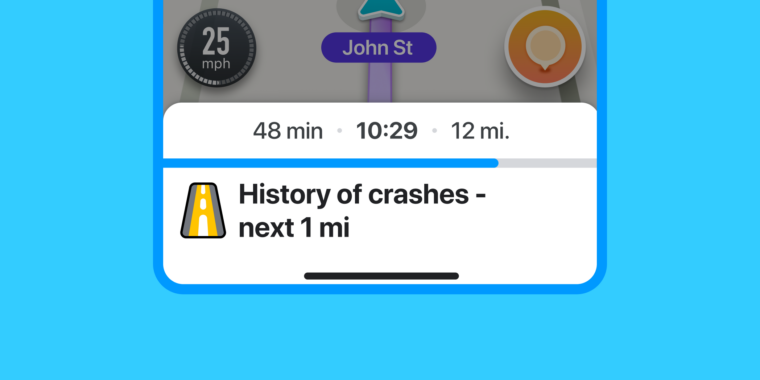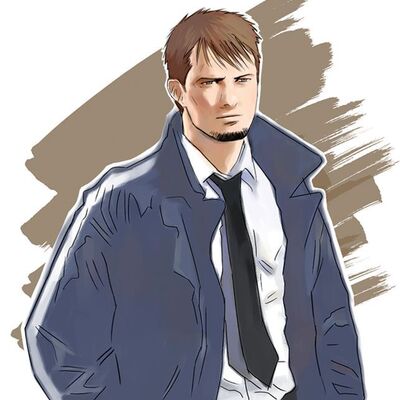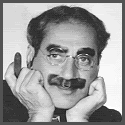Not sure an alert to a history of crashes is great. Now people will take their eyes off the road to read a notification instead of watching the road
In my country there’s sometimes signs that say something like “caution: accident prone area”. I never thought it distracting when driving.
I’m amused at the notion of engineers putting up signs warning everybody that they’re shit at their jobs.
Edit: I’m a former traffic engineer myself, so I’m entitled to say things like that. Frankly, our entire profession is doing it wrong and needs to be reformed.
Shit, it really feels like his point is spot on. If engineers are trying to design for safety, they’re doing a horrible job at it.
I can’t think of a single road I’ve driven down in the US that felt safe for anyone. Too much traffic weaving in and out and through merges and intersections, basically no safe bike lanes, and foot paths so close to fast-moving traffic that you feel like you’re in a wind tunnel.
How does something so endemic like this get fixed?
How does something so endemic like this get fixed?
That’s a very good question. Ultimately, the standards of practice in traffic engineering need to change. Speaking of which: to put a finer point on just how much of an uphill battle that is, consider the fact that even the name itself1 – “traffic engineering” – is biased towards narrow concern for the routing of cars at the expense of holistic consideration of the street as a place. (See also: confessions #2, #20, and #28) There’s a huge amount of institutional inertia supporting the bad status quo, including everything from university curriculum, to standards documents like the AASHTO Green Book and the MUTCD, to the fact that young Engineers-In-Training (EITs) are required to work under existing licensed Professional Engineers (PEs) for about half a decade (it varies depending on circumstances) before being allowed by law to strike out on their own – which on balance is almost certainly a good thing because we definitely don’t want unqualified people stamping plans, but also could lead to being inculcated into old ways of thinking and having latent new urbanist inclinations beaten out of them.
Fun fact: the biggest US traffic engineering research group, one which has an outsize influence in writing those standards documents, is none other than the Texas A&M Transportation Institute (TTI). In Texas. Not that there’s anything wrong with that, but yea.
Anyway, one way for non-engineers to try to help that happen faster – other than bitching about it on social media like I’m doing right now – would be to educate yourself on New Urbanist/Strong Towns/Fuck Cars/etc. ideas, then get involved with your local politics and lobby for said ideas to be implemented. More concretely, read Jane Jacobs and Shoup and watch a bunch of Not Just Bikes videos, then call up your city councilperson, county commissioner and state rep, join whatever citizen planning groups happen to be around (e.g. my city has “NPUs”), and start bitching at those people about it. You can also go to public hearings for road projects and bitch at the engineers directly (they love that sort of thing, LOL).
1 It’s a totally different subject – albeit one I’m also passionate about – but I like to cite this article as a good demonstration of how framing matters. It really can’t just be dismissed as “mere semantics.”
Oh you’d love our “warning: road in poor condition” signs then. Those always tick me off.
I present for your consideration the case of September 3rd, 1967: the day Sweden switched from driving on the left side of the road to the right side. One would expect that the incredibly distracting process of overcoming a lifetime of learned habit would be a recipe for chaos, but in fact there were significantly fewer accidents than average on the day of the change [1].
As it turns out, the danger of complacency outweighs the danger of distraction. It does not particularly matter where one directs their focus if they are not driving mindfully. In a more natural environment, we’re good enough at identifying dangerous situations to pay attention when it matters, but roads are not a natural environment. For every alert person briefly annoyed by an audio notification there will be at least as many pedal-pushers too relaxed to even form coherent memories, let alone engage in defensive driving.[2]
The effect was not permanent, so I will be ignoring the alternative explanation that the new side was somehow massively superior to the extent required to explain the discrepancy. Ditto to the idea that fewer people were driving that one particular day, because the effect did last longer than a single day. ↩︎
Of course, just because someone’s driving absent-mindedly doesn’t mean that they’re stupid. They’ll catch on if you just buzz their phone randomly because you think it’ll prevent crashes. The driver needs to believe that the danger is real which is something that the app has to earn by not being manipulative. ↩︎
That’s a good point. Alerts like that could jolt people back into paying attention, rather than spacing out. It’s disappointing that people could think spacing out while traveling 80mph is okay, but that’s where we are.
The “accident-likely” alerts are a good thing, imo
And, instead of safely driving the road conditions, they’ll wonder where exactly others have crashed and why?
Definitely an unnecessary distraction. I really think the devs for this app don’t drive. They either ride a bike or commute via subway/bus.
What do you mean? Is it a bad idea to prompt people driving vehicles moving over 70 mph as to whether there was a speed trap? But then how will the next people know that need to stop speeding for the next couple miles before they can speed again without recourse?
Literally its best feature. Y’all are fuckin buggin
Seriously. Cops sitting to ticket people are essentially just applying an extra tax to fund their departments. Not giving that to them is a good thing.
I’ve more often seen unsafe driving conditions because of people slowing down to avoid a radar cop than when traffic is flowing predictably and consistently.
While I agree cops looking for money to fund their departments is bad, people willfully endangering those around them is objectively worse.
Speed limits are put in place to keep roads safer. Tickets are a thing meant to incentivize you not to do the dangerous thing that can hurt those around you.
This is literally a tool to help you avoid said punishment, which assists you in doing the dangerous thing with impunity.
I agree cops can be bad. I agree they sometimes are searching for a problem. I agree they often cause other problems.
But speed limits literally and undeniably enforce safety. Something that allows you to circumvent them without recourse literally assists people in doing the unsafe thing.
Sure, cops can be bad. But speeding is unsafe and therefore bad too. It’s not black and white.
You know how else you can stop cops from making this money back? Without assisting in dangerous road behavior? Literally obeying the fucking driving laws. They can’t give you a speeding ticket if you’re not fucking speeding.
I really don’t understand how this shit is even legal.
“Tell me where I can and can’t break laws that were literally put in place so I don’t accidentally fucking kill someone”.
It’s literally built to help people avoid the punishment made to keep people from doing something that’s literally dangerous to the people around them.
I had to turn off the distracting lane assist/warning feature because of so many false positives from inconsistent lane markings, especially in construction zones.
A few warnings is great, too many are so distracting.
That’s a Waze feature??
Just a general comment about excessive false positive warnings.
*crashes while reading Waze prompt about crashes
Exactly. Driving… Driving…BEEP BOOP!..What was that?CRASH!!
It works that well.
It’s a self-fulfilling prophecy.
I wonder if just having a color coded indicator bar, or a unique icon that pops up would work better than a text-based alert.
Or coloring the section of the road accordingly just like it does with slowdowns or traffic jams coloring yellow and red for the stretch ahead.
Now if only every state did vehicle inspections and enforced the laws…
Or better yet, if only engineers did their fucking jobs and fixed negligently-designed areas to be less dangerous.
Edit: I say that as an engineer criticizing my own profession from the inside, by the way.
deleted by creator
Sure, but a lot more crashes are caused by poor design (including design that facilititates law-breaking) than mechanical failures or lack of enforcement.
In particular, I want to address the latter: trying to stop people from speeding by having more police patrols simply doesn’t work. The only thing that does work is physically changing the design of the street (narrowing lanes, etc.) to make it scarier and less comfortable for drivers to go too fast. That’s the engineers’ responsibility, not law enforcement’s.
deleted by creator
Not on freeways, no. The design principles appropriate for freeways are entirely different than the ones appropriate for city streets. It’s the latter where I suspect most of these Waze “dangerous hotspots” will be, and so it’s the latter that I had in mind when writing my previous comment.
deleted by creator
Could you point out an example on Google Maps? Maybe there’s something else wrong with it.
Also, instead of focusing on there still being some speeding despite the street being narrow, consider how much worse the speeding might be if it weren’t.
Seriously - the most dangerous roads I’ve ever been on were in Texas where there were 12 lane highways, and crazy people who wanted to drive 100MPH past you in the right-hand lane, all while people are merging on and off the highway.
Doing the speed limit meant that EVERYONE was driving faster than you, which meant that you were a lot more likely to get rear-ended from someone who didn’t see you in time. You have to speed to stay safe, and then you add in construction zones and it’s just a death trap.
Where is our public transportation option?
the most dangerous roads I’ve ever been on were in Texas where there were 12 lane highways
I understand why you feel like those were the most dangerous, but statistically, freeways are the safest kind of road. It’s places like stroads that you should really be scared of.
Is there any waze alternative based on openstreetmap?
Magic earth is the best, not open source though
This will be amazing. Even if it saves one life (and it will likely save many), it’s a very welcome change
Agreed. Don’t understand why people use Google Maps over Waze unless you’re not in a car.
I used to use Waze, but got tired of it sending me through back streets and turns to save only a minute - problem was, those slower back streets and waiting at junctions ended up taking longer.
Google Maps on the other hand will offer more sane routes, and only send me down back streets where the saving is more than say 4 or 5minutes.
Also, Waze made my phone HOT!
I’m sure Waze used to say that where you know better, use your own initiative rather than blindly follow a machine.
There are settings in Waze to turn off the problems that you encountered. Apps change of you’re lucky. Maybe I’m wrong about maps today; I try it every now and again. Maps is all I use for public transport and walking.
Loving the last comment: nothing like an app to make an old phone, sparkle like new. 😁
I’m here for the angry advocacy of better road design you’re bringing to this post.
Keep it going!
Israëli company
Isn’t it a little late to alert someone of a crash after it’s already a historical fact?









